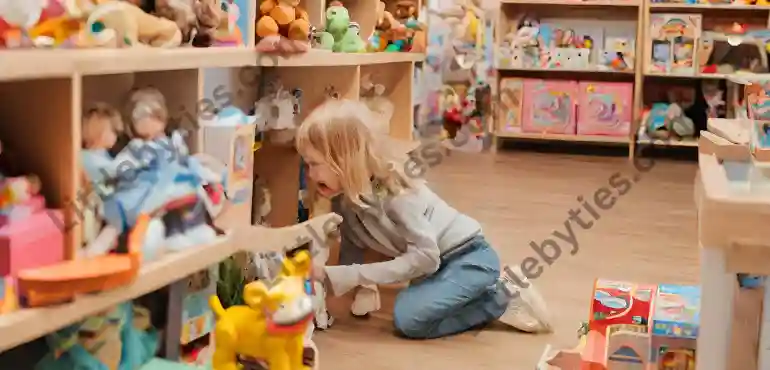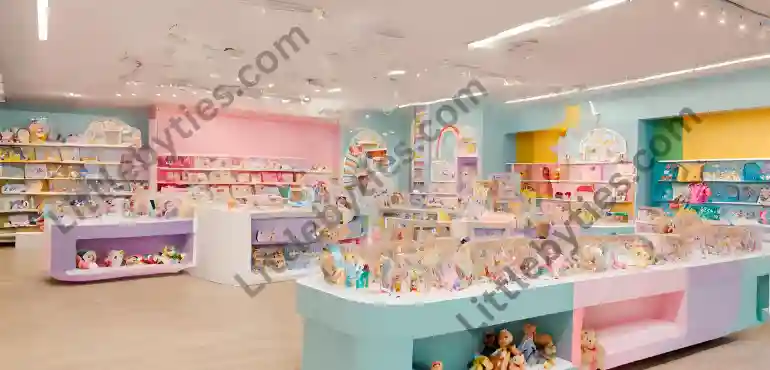Opening a toy store can be a fulfilling entrepreneurial venture, but also requires careful planning and dedication. Here are some key steps to successfully start your own toy business:
Key Takeaways
- Conduct market research to identify your target customers and ideal location
- Choose a business structure and register your company
- Obtain necessary permits, licenses, insurance, and financing
- Find reliable toy manufacturers and wholesalers
- Design your retail space for optimal product display and customer experience
- Stock a balanced selection of classic, educational, and trendy toys
- Develop a unique brand identity and marketing strategy
- Implement robust inventory management and pricing models
- Hire and train knowledgeable, customer-focused staff
- Provide excellent service through product demonstrations, gift-wrapping, loyalty programs, etc.
- Continuously analyze sales data and adjust product mix and operations
A successful toy store delights children of all ages while also operating sustainably as a business. With passion, planning, and dedication, your shop can become a beloved community fixture for years to come.
Selecting the Right Market
Choosing the optimal location and identifying your core demographic are foundational steps when starting a toy business.
Consider opening your shop in areas with:
- High foot traffic such as shopping malls, downtown districts, tourist spots
- Easy accessibility for families with strollers and young children
- Abundant parking or public transportation options
- Low competition from major toy retailers
- Neighborhoods with many families with children
- Proximity to schools, playgrounds, kid-friendly businesses

Your target customers will depend on your location but commonly include:
- Parents of babies, toddlers, and young school-aged children
- Grandparents and relatives looking for gifts
- Schools, daycares, churches, and other organizations
- Collectors of specialty toys like model trains or dolls
Visiting similar stores can reveal helpful insights about merchandising, store layout, pricing, and community fit.
Choosing a Business Structure
Structuring your toy store as a sole proprietorship, partnership, corporation, or LLC impacts legal liability, regulations, taxes, and management style.
Sole proprietorships are simplest to establish but owners assume full liability for debts and obligations.
Partnerships allow sharing of liability and combine owners’ resources, but require carefully crafted partnership agreements.
Corporations are more complex entities that protect personal assets from business liabilities.
LLCs (limited liability companies) provide personal liability protection while allowing business owners flexibility for structuring and taxation.
Consult lawyers and accountants to determine the best structure for your objectives and location.
Registering and Licensing Your Business
Properly register your business by:
- Choosing and registering your business name
- Obtaining a federal EIN and state tax IDs
- Applying for required state and local licenses and permits
- Completing regulatory steps for your chosen business structure
Common toy store permits and licenses include:
- Business license
- Sales tax permit
- Use and occupancy permit
- Fire department permit
- Food handling (if selling food)
- Vendor’s license
Creating a Business Plan
A detailed business plan establishes your toy store’s strategy and helps secure funding. Include:
- Company overview and objectives
- Products/services description
- Market and competitor analysis
- Marketing plan
- Operational plan
- Management team
- Financial projections
Revisit and adapt your plan regularly as the business evolves.
Funding Your Toy Store
Carefully project costs for inventory, equipment, staff, marketing, lease payments, supplies, insurance, etc.
Funding options include:
- Personal savings and assets
- Business loans from banks or government programs
- Crowdfunding
- Grants and incentives
- Investors and business partners
Finding Toy Suppliers and Wholesalers
Develop relationships with manufacturers, distributors, and wholesalers to acquire inventory at competitive prices.
- Attend toy industry trade shows and conventions to network and find suppliers
- Research options online, in industry directories, or through referrals
- Negotiate minimum order volumes, pricing, and delivery terms
- Build long-term partnerships with vendors for exclusives and reliable supply
Diversify your suppliers to mitigate risk if any fall through. Order samples before making large inventory commitments.
Designing Your Retail Space
Strategically design your store’s layout to maximize sales while maintaining an inviting atmosphere.
- Allow ample room in aisles and between displays for strollers and multiple visitors
- Utilize slat walls, shelves, bins, and display cases to showcase products
- Group toys by age, type, brands, themes, or price points
- Feature new releases and seasonal items prominently
- Consider space for birthday parties, play areas, or craft demonstrations
- Accommodate stroller parking, seating for parents, and customer restrooms

Stocking Your Toy Store Inventory
Carefully select toys aligned with your brand, values, and target demographic. Prioritize:
- Classic, enduring toys like Lego, board games, stuffed animals
- Educational STEM toys, crafts, and building sets
- Licensed toys of popular kids’ entertainment brands
- Unique artisan or niche toys not found in big box stores
- Toys across a range of age groups and price points
- Gender neutral options appealing to all children
Additionally, carry supplemental items like:
- Children’s books, apparel, and decor
- Gift wrap, tissue paper, bows, gift bags and tags
- Party supplies for birthdays and celebrations
Update seasonal merchandise regularly. Ride trends cautiously, ensuring sufficient demand exists.
Creating Your Brand Identity
Define your toy store’s unique brand identity through:
- Brand name, logo, and slogans
- Store design aesthetic
- Merchandise mix and specialties
- Pricing and service model
- Website and social media presence
- Staff culture and values
- Community engagement and outreach
Align your brand closely with your target audience. For example, focus on educational toys vs low cost toys.
Hiring and Training Staff
Sales associates directly influence the customer experience, so hire carefully:
- Look for warm, patient, and energetic personalities
- Toy knowledge and sales skills are pluses
- Balance mature staff with youthful perspectives
- Perform background checks
Train employees on:
- Store policies and procedures
- Product information and inventory organization
- Point of sale operations and technology
- Security practices
- Providing excellent customer service
Foster teamwork and encourage staff product feedback. Incentivize through commissions or rewards programs.
Marketing and Promotions
Build local awareness of your store by:
- Having a high-quality website and active social media presence
- Running email newsletters, blogs, contests, and social promotions
- Sponsoring community events and participating in local festivals
- Hosting in-store events like new toy demonstrations or game nights
- Placing ads in parenting magazines, activity guides, and school notices
- Partnering with schools, non-profits, or children’s organizations
- Issuing press releases to media contacts about new store openings
Word-of-mouth referrals are powerful – focus on delighting each customer.
Setting Prices and Policies
Pricing models balance profitability with competitiveness. Options include:
- Matching competitors’ prices on popular toys
- Moderate markups on specialty toys not widely available
- Loss leader pricing on some items to attract customers
- Bundled deals and bulk purchase incentives
- Dynamic pricing aligned to demand and inventory levels
- Loyalty discounts for frequent shoppers
Standardize store policies on:
- Accepted payment methods
- Delivery and shipping options
- Returns, refunds, and exchanges
- Discounts and sales schedules
- Handling product recalls and complaints
Post policies clearly in-store and online. Update as needed over time.
Managing Inventory
Leverage inventory systems to optimize stock levels, avoid excess storage fees, and minimize waste.
- Closely track sales volume and trends for each product
- Reorder top performers before they sell out
- Return slow sellers to suppliers to free up cash and space
- Mark down aging products, discontinues, and seasonal items
- Safeguard inventory in locked cases and monitor for theft
- Perform periodic inventory audits and cycle counts
Providing Excellent Customer Service
Make visiting your toy store a joy for families by:
- Offering personal shopping assistance and product recommendations
- Demonstrating toys and allowing children to test drive products
- Providing complimentary gift wrapping
- Hosting kid-friendly events and entertainment
- Implementing loyalty reward programs
- Sending birthday coupons or thank you notes
- Resolving issues promptly and courteously
Go above and beyond to create a fun, welcoming environment where kids and parents want to spend time and make memories.
Ikram Ullah is a seasoned content writer and editor hailing from Faisalabad, Pakistan, boasting a decade of rich experience in SEO and content writing. He is particularly distinguished in the realm of technology content writing, where he excels at demystifying complex technological concepts, making them accessible and engaging for a broad audience. Throughout his career, Ikram has made significant contributions to various websites, showcasing his commitment to technological advancements and his skill in creating informative and compelling content. His portfolio includes work for littlebyties.com, republicansunited.com, and invisiblelocs.net, each reflecting his dedication and expertise in the field.